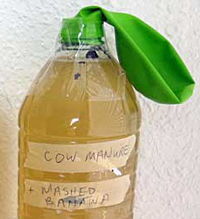Turning Biomass into Biofuel: These Cows Are Making Massive Amounts of Potential Alternative Energy
Living on a farm can be smelly business. But stinky piles of biowaste can hold the key to an alternative energy solution that can have a major impact on a farm's available energy and power. Get inspired by one dairy's success and find out how you can explore the potential of turning waste, trash, and other unexpected bio sources into alternative energy.
A recent story in the New York Times spotlighted Fair Oaks Farms, an Indiana-based, family-owned-and-operated dairy that has turned its five million pounds of daily cow manure into a sustainable stream of natural energy that powers its dairy and farm operations as well as a fleet of tractor-trailer trucks that make daily deliveries to milk processing facilities. According to the story, shifting the delivery trucks to also use the farm-produced biogas was a logical next step in Fair Oaks' alternative energy planning and helped the dairy find a way to convert potential biofuel that was being left unused into an environmentally-conscious solution—one with a marked impact on fossil fuel use and emissions. The dairy estimates that their use of biofuel for the delivery trucks will "take two million gallons of diesel off the highway each year."
For Fair Oaks, upcycling biowaste is a solution that makes sense, from the piles of manure up. They already have the bio source (the cows), and the piles of waste accumulate daily, whether they use them or not. Their success, and the amount of self-sustaining power they are generating, tells an inspiring story about the potential of biofuel. On the level of a single farm, Fair Oaks has created an ecosystem that connects their herds to the production of both their dairy products and of the energy that runs the whole operation.
Making Connections
Turning biowaste into natural gas is one approach to creating an alternative energy solution. Cow manure contains methane, a biogas, which can be captured and used for energy. Other sources of biomass are also possible for use in the production of biofuels or agrofuels. Corn for gas? Your compost bin as a source of household power?
Students who are interested in biochemistry-based alternative and renewable energy can explore issues, challenges, and possible approaches in the following hands-on science Project Ideas:
- "From Trash to Gas: Biomass Energy": what kinds of biomass are good for making biogas? The results will be visible as methane builds up and inflates balloons used in the collection devices!
- "Burning Biofuels: Comparing Nonrenewable and Renewable Fuels": do agrofuels produce the same amount of energy as nonrenewable fuels? Compare vegetable oil and motor oil to explore.
- "Turn Plants into Biofuel with the Power of Enzymes *": is the production of biofuel too slow? Investigate problems related to the time it takes for cellulosic ethanol production reactions to occur and see whether or not an enzyme can make a difference in the production process.
- "Go Green by Growing Green: How to Extract Energy from Grass": is potential alternative energy as close as your backyard? Grow different kinds of grasses to see which ones can be used as good sources of biomass energy.
To read the full New York Times story, see: "Dairy Finds a Way to Let Cows Power Trucks."
Science Buddies Project Ideas in biotechnology techniques are sponsored by Bio-Rad Laboratories.
Categories:
You Might Also Enjoy These Related Posts:
- Inspiring AAPI Scientists and Engineers - Asian American and Native Hawaiian/Pacific Islander Heritage Month
- Plastics and Earth Day - Science Projects
- Arduino Science Projects and Physical Computing
- 10+ Robotics Projects with the BlueBot Kit
- 5 STEM Activities with Marshmallow Peeps
- March Madness Basketball Science Projects: Sports Science Experiments
- Women in STEM! More than 60 Scientists and Engineers for Women's History Month
- Explore Artificial Intelligence and Machine Learning with Student AI Projects









